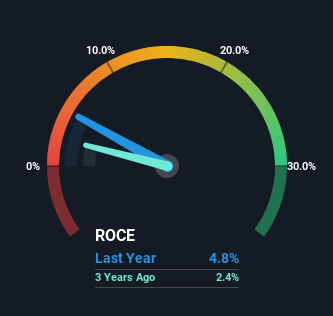
Did you know there are some financial metrics that can provide clues of a potential multi-bagger? Firstly, we'd want to identify a growing return on capital employed (ROCE) and then alongside that, an ever-increasing base of capital employed. If you see this, it typically means it's a company with a great business model and plenty of profitable reinvestment opportunities. However, after investigating Diwang Industrial Holdings (HKG:1950), we don't think it's current trends fit the mold of a multi-bagger.
What Is Return On Capital Employed (ROCE)?
If you haven't worked with ROCE before, it measures the 'return' (pre-tax profit) a company generates from capital employed in its business. To calculate this metric for Diwang Industrial Holdings, this is the formula:
Return on Capital Employed = Earnings Before Interest and Tax (EBIT) ÷ (Total Assets - Current Liabilities)
0.048 = CN¥31m ÷ (CN¥738m - CN¥96m) (Based on the trailing twelve months to December 2023).
Thus, Diwang Industrial Holdings has an ROCE of 4.8%. Ultimately, that's a low return and it under-performs the Chemicals industry average of 6.2%.
See our latest analysis for Diwang Industrial Holdings

Historical performance is a great place to start when researching a stock so above you can see the gauge for Diwang Industrial Holdings' ROCE against it's prior returns. If you're interested in investigating Diwang Industrial Holdings' past further, check out this free graph covering Diwang Industrial Holdings' past earnings, revenue and cash flow.
What Can We Tell From Diwang Industrial Holdings' ROCE Trend?
On the surface, the trend of ROCE at Diwang Industrial Holdings doesn't inspire confidence. Around five years ago the returns on capital were 27%, but since then they've fallen to 4.8%. Although, given both revenue and the amount of assets employed in the business have increased, it could suggest the company is investing in growth, and the extra capital has led to a short-term reduction in ROCE. If these investments prove successful, this can bode very well for long term stock performance.
On a related note, Diwang Industrial Holdings has decreased its current liabilities to 13% of total assets. So we could link some of this to the decrease in ROCE. Effectively this means their suppliers or short-term creditors are funding less of the business, which reduces some elements of risk. Since the business is basically funding more of its operations with it's own money, you could argue this has made the business less efficient at generating ROCE.
What We Can Learn From Diwang Industrial Holdings' ROCE
In summary, despite lower returns in the short term, we're encouraged to see that Diwang Industrial Holdings is reinvesting for growth and has higher sales as a result. But since the stock has dived 92% in the last three years, there could be other drivers that are influencing the business' outlook. Regardless, reinvestment can pay off in the long run, so we think astute investors may want to look further into this stock.
If you want to know some of the risks facing Diwang Industrial Holdings we've found 2 warning signs (1 is a bit concerning!) that you should be aware of before investing here.
While Diwang Industrial Holdings isn't earning the highest return, check out this free list of companies that are earning high returns on equity with solid balance sheets.
Have feedback on this article? Concerned about the content? Get in touch with us directly. Alternatively, email editorial-team (at) simplywallst.com.
This article by Simply Wall St is general in nature. We provide commentary based on historical data and analyst forecasts only using an unbiased methodology and our articles are not intended to be financial advice. It does not constitute a recommendation to buy or sell any stock, and does not take account of your objectives, or your financial situation. We aim to bring you long-term focused analysis driven by fundamental data. Note that our analysis may not factor in the latest price-sensitive company announcements or qualitative material. Simply Wall St has no position in any stocks mentioned.
Have feedback on this article? Concerned about the content? Get in touch with us directly. Alternatively, email editorial-team@simplywallst.com